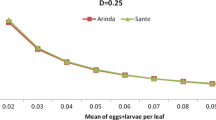Abstract
In pest management, the pest density within a group of plants needs to be estimated for taking timely actions, such as spraying pesticides or releasing natural enemies. Taylor’s power law is widely used for identifying the aggregation patterns of the pests and designing a sequential sampling plan to estimate the pest mean density. The conventional estimates given by Taylor’s power law do not consider potential density differences due to various covariates, but focus only on the relationship between the sample means and the variances.
In this article, we develop a new sequential sampling stop line based on Taylor’s power law by using quasi-likelihood with covariate effects. The simulation results show that the proposed estimators are better than the conventional estimators in terms of mean squared error. For validation and evaluation of the sampling stop line given by the proposed estimator, we use RVSP software in which actual observations are randomly and iteratively sampled until the total number of a pest reaches the stop line. We demonstrate both types of sequential sampling stop lines, those based on the conventional method and those based on the new method, for the population density of spider mites on glasshouse roses.
Similar content being viewed by others
References
Aitken, M. (1987), “Modelling Variance Heterogeneity in Normal Regression Using GLIM,” Applied Statistics, 36, 332–339.
Breslow, N. (1990a), “Further Studies in the Variability of Pock Counts,” Statistics in Medicine, 9, 615–626.
— (1990b), “Tests of Hypotheses in Overdispersed Poisson Regression and Other Quasi-Likelihood Models,” Journal of the American Statistical Association, 85, 565–571.
Carroll, R. J., and Ruppert, D. (1988), Transformation and Weighting in Regression, London: Chapman & Hall.
Carroll, R. J., Ruppert, D., and Stefanski, L. A. (1995), Measurement Error in Nonlinear Models, London: Chapman & Hall, p. 270.
Cressie, N. A. C. (1993), Statistics for Spatial Data, New York: Wiley.
Davidian, M., and Carroll, R. J. (1987), “Variance Function Estimation,” Journal of the American Statistical Association, 82, 1079–1091.
Davis, P. M., and Pedigo, L. P. (1989), “Analysis of Spatial Patterns and Sequential Count Plans for Stalk Borer (Lepidoptera: Noctuidae),” Environmental Entomology, 18, 504–509.
Diblasi, A., and Bowman, A. W. (2001), “On the Use of the Variogram in Checking for Independence in Spatial Data,” Biometrics, 57, 211–218.
Green, R. H. (1970), “On Fixed Precision Level Sequential Sampling,” Researches on Population Ecology, 12, 249–251.
Hutchison, W. D., Hogg, D. B., Poswal, M. A., Berberet, R. C., and Cuperus, G. W. (1988) “Implications of the Stochastic Nature of Kuno’s and Green’s Fixed-precision Stop Lines: Sampling Plans for the Pea Aphid (Homoptera: Aphididae) in Alfalfa as an Example,” Journal of Economic Entomology, 81, 749–758.
McCullagh, P., and Nelder, J. A. (1989), Generalized Linear Models, London: Chapman & Hall.
Moran, P. A. P. (1948), “The Interpretation of Statistical Maps,” Journal of the Royal Statistical Society, Ser. B, 10, 243–251.
Naranjo, S. E., and Hutchison, W. D. (1997), “Validation of Arthropod Sampling Plans Using a Resampling Approach: Software and Analysis,” American Entomologist, 43, 48–57.
Nelder, J. A., and Lee, Y. (1992), “Likelihood, Quasi-likelihood, and Pseudolikelihood: Some Comparisons,” Journal of the Royal Statistical Society, Series B, 54, 273–284.
Perry, J. N. (1981), “Taylor’s Power Law for Dependence of Variance on Mean in Animal Population,” Applied Statistics, 30, 254–263.
SAS Institute, (1997), SAS User’s Guide, 6.14., Cary, NC: SAS.
SAS Institute (1993), SAS/STAT Software: The GENMOD Procedure, Technical Report P-243, 81–85.
Southwood, T. R. E. (1978), Ecological Methods (2nd ed.), London: Chapman and Hall, p. 391.
Taylor, L. R. (1961), “Aggregation, Variance and the Mean,” Nature (Lond.), 189, 732–735.
— (1974), “Monitoring Change in the Distribution and Abundance of Insects,” Annual Report of Rothamsted Experimental Station, 1973(2), 202–239.
Taylor, R. A., Lindquist, R. K., and Shipp, J. L. (1998), “Variation and Consistency in Spatial Distribution as Measured by Taylor’s Power Law,” Environmental Entomology, 27, 191–201.
Wedderburn, R. W. M. (1974), “Quasi-likelihood Functions, Generalized Linear Models and the Gauss-Newton Method,” Biometrika, 61, 439–447.
Author information
Authors and Affiliations
Corresponding author
Rights and permissions
About this article
Cite this article
Park, H., Cho, K. Use of covariates in Taylor’s power law for sequential sampling in pest management. JABES 9, 462 (2004). https://doi.org/10.1198/108571104X15746
Received:
Revised:
DOI: https://doi.org/10.1198/108571104X15746




